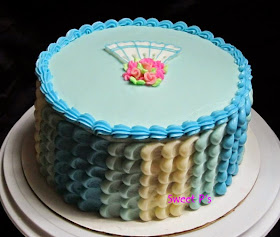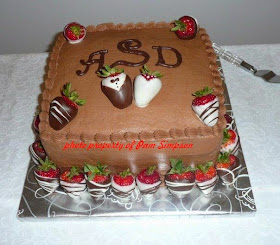Frozen Buttercream Transfer Tutorial
There are a lot of frozen buttercream transfer tutorials on the internet. Google it and you will find several on blogs and on youtube. So, why am I adding my own to the mix? Well, why not? In this tutorial, I will show why I like using FBCTs and address some of the issues I have had using them.
A frozen buttercream transfer is a relatively simple technique that allows for a picture and/or logo to be placed on a cake. I enjoy using them because I am terrible at drawing and this technique allows me to "draw" a picture on cake. Just takes a little patience and care.
I used the
FBCT technique on these cakes in order to get the school logo and/or mascot.
Supplies Needed
You will need:
- a flat surface on which to tape your pattern to that you can also pipe on and transport to and from the freezer. It can be a cookie sheet, cake cardboard, glass, etc. I like to use a piece of acrylic that I purchased at a hardware superstore.
- something to pipe on. This can either be wax paper, parchment paper or acetate. I prefer to use clear acetate because it is easier to view the pattern underneath, but I have also used wax paper.
- a piping bag filled with a medium to medium-stiff icing that you want to use as an outline color (most of the times this will be black). NOTE: You can do FBCT without an outline but is is easier to have an outline.
- piping bags filled with a medium to thin icing to fill in. These will be all the colors you use for your pattern.
- various sizes of round (writing) tips. The size depends on the level of detail you are trying to achieve and the area (size) that you have to cover.
- art brush or toothpick to move icing into corners and missed spots.
Preparing Your Work Surface
Take your pattern (a coloring book page, image found on the web, party invitation, etc.) and prepare a mirror image. If your image is on the web, you can easily flip the image. If your pattern is a coloring book page or invitation, you can use a copier to reverse the image or you can trace your pattern onto parchment paper then flip it over. If you don't start out with a mirror image, your FBCT will turn out flipped horizontally from your original. This may not be a big deal except if you have writing on your image. The more detailed and the more colors that are in your picture, the harder it will be to pipe cleanly. In this example, I took a permanent marker and went over the outlines to help them stand out even more.
Once you are happy with your pattern, tape it to your flat work surface. If you are using a cookie sheet, tap the pattern on top of it. If you are using a clear surface like glass or plexiglass, you can tape it to the underside. Next, tape your wax paper, parchment or acetate to the top of the pattern. NOTE: Before you start piping, make sure your flat work surface will fit in the freezer.
Piping the Outline
If you want to tint your own icing black (or whatever outline color of your choosing), feel free to do so. However, if I am using black I generally will use a pre-made black icing because it is very difficult to get a true black icing on your own. In the picture above, you can see where I used a tube of black icing- this is more like royal icing and not buttercream. I cut the "seam" end of the tube off, scoop it out and put it in a bowl, and thin it to the consistency that I want. Once the out line is done, I put the transfer in the freezer to harden the outline.
Piping the Inside
Couple of things to keep in mind as you pipe the rest of the design.
It's generally easier to pipe from the middle out so you minimize the risk of dragging your hand in what you have already piped.
You must keep in mind that this image will be "flipped" so you are looking at the backside while you are piping. This requires that you pipe any details that are "in front" first. This includes any highlights (like this image had highlights in the sunglasses that I needed to pipe before filling in the black part of the glasses).
You will use smaller tips for little details and filling in tight spots and bigger tips for filling in large areas. Remember that stiff icing will be very difficult to pipe through a small tip. It may be tempting to pipe lines back and forth to cover the spaces but the image will look better if you can keep the tip inserted in the icing as you pipe and use a little circular motion. When you use very small tips (1 or 0), you may get bits of icing sugar stuck in the opening. This is why I like to use couplers with small tips. I can easily screw the coupler off, unclog the tip and put it back together.
Once you have piped one color or area and before you start on the next color, place your transfer in the freezer for a few minutes to let icing firm up. This makes it so much easier to get clean lines without the colors inadvertently mixing.
From time to time, check your piping from the front side to see if you missed any spots. There will usually be tiny areas that the icing did not get into. Take a small paintbrush or toothpick and gently coax icing into those spots.
When you are satisfied with how your design looks, put it in the freezer to harden. Remember, you are looking at the "back". This side will be against the cake.
Once it is hard enough where you won't mess it up, pipe a layer of icing on the back (the same color as the icing on your cake) and smooth it over with a small spatula. This adds stability. Try to get this icing as smooth and even as possible.
If there are high and low spots, your transfer will have dips (and may even break) at the low spots as the icing thaws once it is on your cake. BUT, be aware that the thicker your transfer is, the higher it is going to stand up off your cake. Personally, I like to use a small, tapered spatula to smooth out the back. Place it back in the freezer one last time. At this point, I usually take off all the tape that had been holding my pattern in place. I want to get it on the cake as soon as possible after it comes out of the freezer and I don't want to be fumbling around with the tape.
Placing it on the cake
After your transfer has sufficiently hardened, it is time to place it on your cake. The amount of time it stays in the freezer is completely up to you. I have left them in there as little as 30 minutes or as long as overnight. However, once you take it out, it will start to thaw immediately so you need to work quickly. Have your cake already iced and have pre-determined where the FBCT will be placed. Take a quick look at your FBCT to make sure you have it oriented in the right direction. Place it flat on your cake and gently press. Peel off your wax paper or acetate to reveal your masterpiece. If your FBCT is wanting to stick, put the whole thing (cake and all) back in the freezer to firm back up. If you notice a lot of "lines" in the surface, wait until it has thawed, finished condensating and crusted a bit before placing a Viva paper towel or piece of parchment paper on it and gently rubbing out those lines. You may wish to leave your FBCT like it is or place a border around it.
Here is the finished cake:
 |
| FBCT without border |
 |
| FBCT with border |
More examples of FBCT:

























































